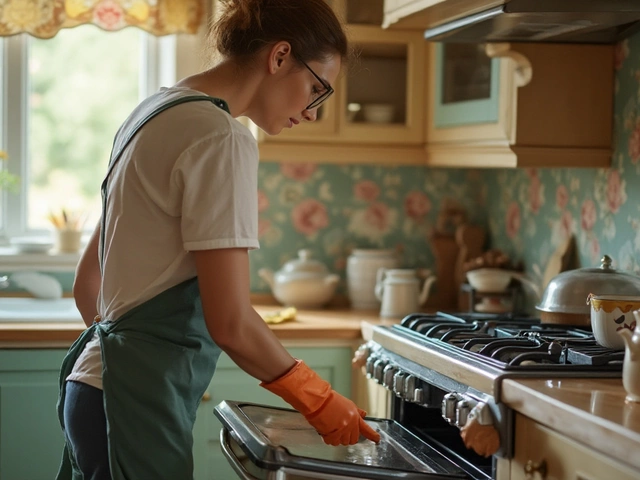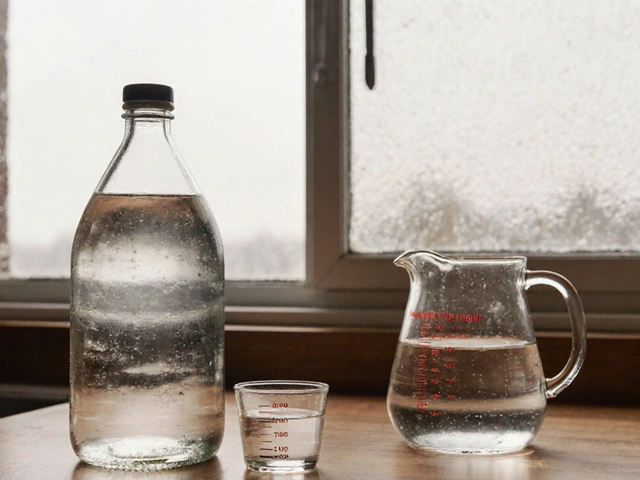In today's world, making your home eco-friendly is more than just a trend—it's a step towards a healthier lifestyle and a cleaner planet. Many people are turning to sustainability not only in their living spaces but also in their cleaning practices. Swapping traditional cleaning agents for greener alternatives can make a big difference. But where do you start?
This guide is here to walk you through the ins and outs of eco-friendly cleaning, offering practical advice and insights on making your own natural cleaning solutions, reducing waste, and utilizing the best that nature has to offer. Dive into this journey to learn how small changes can have a significant impact, not just on your home, but also on our environment.
- Understanding Eco-Friendly Cleaning Products
- DIY Natural Cleaning Solutions
- The Benefits of Eliminating Toxins
- Reduce, Reuse, Recycle: Cleaning Supplies Edition
- The Power of Plants in Cleaning
- Building Sustainable Cleaning Habits
Understanding Eco-Friendly Cleaning Products
In embarking on the journey to create a more sustainable home, embracing eco-friendly cleaning products is a pivotal step. These products are thoughtfully crafted to minimize environmental impact, often utilizing biodegradable ingredients and reducing harmful residue that can affect both water systems and living organisms. As individuals increasingly seek alternatives to traditional chemical cleaners, it's essential to understand the composition and benefits of these eco-friendly solutions.
Manufacturers of eco-friendly cleaning products prioritize the use of natural components like vinegar, baking soda, and essential oils. These ingredients not only enlighten our senses but also pack powerful cleaning abilities without the harsh side effects of synthetic chemicals. Brands often commit to transparency, listing all ingredients openly on their labels, which assists consumers in making informed decisions. For example, choosing cleaners with plant-based surfactants over petrochemical-based alternatives not only proves effective but significantly lowers our carbon footprint.
Key Benefits of Eco-Friendly Cleaning Products
The advantages of adopting eco-friendly cleaning solutions extend beyond just maintaining a spotless home. One of the primary benefits is the improvement of indoor air quality. Conventional cleaners often release volatile organic compounds (VOCs) into the air, contributing to respiratory issues and allergies. In contrast, natural cleaners typically do not emit such noxious gases, creating a healthier living environment. Furthermore, opting for green cleaning aids conserves natural resources, as they are often packaged in materials that can be recycled or reused, enhancing the sustainability of your purchase.
According to a study by the Environmental Working Group, “people exposed to conventional cleaning products on a regular basis have higher rates of asthma and other chronic conditions related to the respiratory system.”
While exploring the retail landscape, it's beneficial to understand certification labels that advocate for sustainable practices, such as Green Seal or the EPA's Safer Choice label. These certifications ensure the products meet rigorous performance standards while being environmentally friendly. Interestingly, as more companies delve into sustainable practices, they innovate to enhance efficacy without compromising on environmental ethics. This emphasis on quality is pivotal, as it dispels the myth that natural solutions are ineffectual compared to their chemical counterparts.
Navigating Eco-Friendly Product Labels
Interpreting product labels is crucial in identifying the truly sustainable from the greenwashed. Look for specifics in claims, such as “biodegradable in 28 days,” which provides a clear understanding of its decomposition. It's equally important to recognize that not all-natural products have the same environmental impact. For instance, some producers may source ingredients that demand excessive water or land resources, which monikers such as 'locally sourced' or 'sustainably harvested' can help navigate.
To illustrate the growing trend of sustainable home practices, consider this: the global green cleaning product market is expected to reach 11 billion USD by 2027, reflecting a significant increase in consumer demand for environmental responsibility. This shift not only infers a decline in the acceptance of potentially harmful products but also an encouragement of positive environmental stewardship across the board.
DIY Natural Cleaning Solutions
Turning to natural cleaners not only helps reduce your carbon footprint but also ensures a healthier environment within your home. Most store-bought cleaning products contain chemicals that can be harmful when inhaled or left on surfaces where they may be accidentally ingested. However, with just a few ingredients that you probably already have in your kitchen, you can create effective and safe alternatives that serve your cleaning needs. For instance, simple kitchen staples like vinegar, baking soda, and lemon are known for their powerful cleaning properties.
Vinegar is an incredible disinfectant and can shine surfaces effortlessly. When you mix it with water in a spray bottle, you have an all-purpose cleaner ready to tackle grease and grime. For deodorizing carpets and freshening up your laundry, baking soda comes in handy due to its excellent odor-neutralizing capabilities. Pairing it with vinegar can also create a chemical reaction that lifts stains from surfaces effectively. As for lemons, their acidity acts as a natural bleaching agent and a grease cutter, making them perfect for cleaning cutting boards, sinks, and even windows.
While these ingredients work wonders on their own, combining them can enhance their effectiveness. For example, mixing baking soda and vinegar can unclog drains. To surprise you, many essential oils carry antibacterial properties, adding not only an extra cleaning punch but also a pleasant scent to your home. A few drops of tea tree oil in your homemade cleaner can elevate it to another level with its antimicrobial power. As noted by a study from Harvard University's School of Public Health, incorporating natural ingredients in household cleaning dramatically reduces toxic exposure and benefits indoor air quality.
"Using natural cleaning products at home not only enhances the living environment but fosters the well-being of its occupants by minimizing exposure to harmful substances," explains Dr. Anna E. McAlister, an environmental health expert.
Suppose you are ready to embrace these eco-friendly cleaning methods. In that case, here’s a basic recipe to start with: in a large bowl, combine two parts water, one part vinegar, and a few drops of your choice of essential oil. Store this solution in a spray bottle and apply it liberally to dirty surfaces before wiping it clean with a microfiber cloth. You’ll find this mixture effective for multiple areas of the home, from kitchen counters to bathroom sinks. By switching to DIY solutions, you take another step toward a sustainable home and contribute to a greater cause by reducing the demand for chemical-laden products.
Here’s a quick look at how these ingredients can be used individually and combined for optimal cleaning results:
- Baking Soda & Lemon: Perfect for scrubbing and removing stains on bathroom tiles.
- Vinegar & Water: Use as an everyday surface cleanser, especially in kitchens.
- Lemon & Salt: Effective for removing rust from cutlery and other metallic items.
- Baking Soda & Essential Oils: Ideal for carpet fresheners when sprinkled and vacuumed.
Embracing sustainable home practices through natural DIY cleaners is a rewarding endeavor. Not only do you improve your home environment, but you also encourage a lifestyle that aligns with eco-friendliness. Simple swaps like these gradually lead to bigger changes, fostering a greater sense of awareness and responsibility towards the planet.

The Benefits of Eliminating Toxins
Incorporating eco-friendly cleaning methods in your daily routine not only safeguards the environment but also provides a safe haven for you and your family. Traditional cleaning products often harbor a cocktail of chemicals that can invade your home atmosphere, contributing to indoor air pollution far worse than what's found outside. Researchers have noted that volatile organic compounds (VOCs) present in typical household cleaners can lead to respiratory problems, allergies, and even chronic diseases. So, choosing to eliminate these toxins becomes an investment in your health, decreasing potential irritants and allergens that could harm sensitive individuals.
Switching to natural cleaners doesn't mean compromising on cleanliness or effectiveness. Many natural alternatives are powerful enough to tackle household grime without the risky side effects brought on by their chemical counterparts. For example, ingredients like vinegar and baking soda have been lauded for their ability to cut through grease and disinfect surfaces, offering a cleaner that rivals conventional means without adverse effects. According to a study by the Environmental Working Group, individuals exposed to cleaner fumes regularly might experience reduced lung function over time. Knowing this, transitioning to green cleaning becomes an act of self-care, preserving not only the environment but the sanctuary of your home.
Eliminating harmful chemicals from your cleaning routine also contributes to a greener planet. Each year, homes collectively dump tons of synthetic chemicals into our water systems. These substances often resist natural degradation, accumulating in our ecosystems and causing havoc on wildlife and plant life. By choosing biodegradable and natural solutions, you reduce your carbon footprint significantly. According to the U.S. Environmental Protection Agency (EPA), over 50% of human exposure to pollutants is indoors, indicating that household decisions have a significant silver lining when oriented towards sustainability.
"One of the greatest challenges and opportunities for today's homeowners is reducing personal exposure to toxins," says Dr. Anne Steinemann, a leading researcher in environmental and consumer health. "Shifting to natural solutions for cleaning not only helps the planet but our own health as well."
Another overlooked benefit of adopting greener cleaning supplies is the potential savings it presents. Many DIY cleaning solutions use ingredients that are already present in most homes, such as citrus peels, essential oils, and common pantry items, cutting down the need for specialized products. The eco-conscious consumer finds that sustainability does not only refer to environmental impact but also financial acuity, reducing costs related to medical bills stemming from chemical exposure and preserving products from excessive wear and degradation from harsh chemicals.
Finally, a shift towards greener practices empowers consumers. When you choose products with clear, honest labeling, you support businesses that prioritize transparency and accountability. This shift echoes into a demand for cleaner practices industry-wide, creating a ripple effect of change. As demand for sustainable options grows, manufacturers are more likely to invest in eco-friendly innovations, contributing to a cycle of positive change. Thus, by eliminating toxins from your household, you become part of a larger narrative pushing for systemic shifts towards a sustainable future.
Reduce, Reuse, Recycle: Cleaning Supplies Edition
Incorporating the principles of reduce, reuse, and recycle into your cleaning routine can significantly minimize your environmental footprint. By evaluating the lifecycle of your cleaning supplies, you can make conscious decisions that prioritize sustainability without sacrificing cleanliness. Begin by examining the products you purchase. Many cleaning supplies come in excessive packaging, often made of non-recyclable materials. Opt for brands that use biodegradable or reusable packaging. Transitioning to concentrated formulas can also cut down on waste, as these often come in smaller containers that last longer and even require less energy to produce.
Now let’s address reuse. Before discarding an item, consider how it might be repurposed for cleaning. An old t-shirt can become a perfect cloth for dusting. Glass jars, once emptied and cleaned, make excellent storage containers for homemade cleaning concoctions. This not only saves money but also reduces the demand for new resources. Also, consider investing in high-quality, durable cleaning tools that can withstand years of use. This contrasts with the disposable mindset that drives so much of current consumption. According to the Environmental Protection Agency, reducing waste can conserve energy and cut down emissions from combustion and converting manufacturing processes.
"The world's a mote of dust suspended in a sunbeam," mused Carl Sagan, reminding us of the finite resources at our disposal—each decision, no matter how small, contributes to a broader impact.Recycling is the final part of this eco-trio and plays a crucial role in waste management. After maximizing reduction and reuse, ensure leftover items find their way to the recycling bin instead of the trash. For instance, many municipalities offer recycling programs for plastic spray bottles and containers. Familiarize yourself with local guidelines to make sure your efforts are effective. Keep in mind, every recycled item saves that equivalent amount of raw material from being harvested anew.
Implementing these practices not only champions green living but can also inspire those around you to adopt similar habits. When you integrate sustainable home strategies into your cleaning regime, you're modeling responsible consumer behavior. Encourage friends and family by sharing tips and even compiling a list of local recycling resources. After all, change begins at home, and a concerted effort in household routines can propel society forward in monumental ways. Witnessing the tangible benefits of reducing, reusing, and recycling—from a drop in garbage collection fees to a cleaner conscience—offers motivation more profound than anything else.

The Power of Plants in Cleaning
Plants have always held a revered place in the world of eco-friendly cleaning, thanks to their natural ability to cleanse and purify not just our bodies, but also our homes. Using plants and their extracts can dramatically reduce our reliance on harsh chemicals that threaten both our health and our environment. Take, for example, the simple yet powerful lemon. Lemon juice, with its natural antiseptic and antibacterial properties, is a fantastic cleaner for almost every surface. The acidity in lemons helps break down grime, while its natural oils add a pleasant scent, leaving everything fresh and clean. By using a simple mixture of lemon juice and water, one can easily clean countertops, glass, and even stubborn stains.
However, lemons aren’t the only stars in the realm of natural cleaning; many herbs and plants can double as cleaning agents. Consider the ubiquitous lavender, which isn't just beloved for its calming aroma. Lavender oil possesses antimicrobial and antibacterial qualities making it an ideal choice for disinfectants. A few drops added to a mixture of vinegar and water create a powerful yet gentle floor cleaner. There's a remarkable sense of accomplishment in relying on nature’s bounty to maintain a clean living space. A 2021 study corroborates that households using plant-based cleaning methods reported fewer instances of respiratory issues and allergies.
As a representative from the Environmental Working Group once stated, “Incorporating plant-based solutions in our daily cleaning routine is not just a nod to tradition, but also a step toward a more sustainable future.”
Then there's the ever-versatile vinegar, an age-old stalwart in the lineup of natural cleaners. Derived from fermenting plants like corn, vinegar is known for its powerful ability to cut through mineral deposits and mildew. When combined with baking soda, it becomes a formidable cleaner that can deodorize and disinfect surfaces efficiently. For a practical approach, wipe down greasy surfaces in the kitchen using a diluted vinegar solution or freshen up your bathroom tiles by spritzing a vinegar-water mix, allowing it to sit before gently scrubbing. Notably, these methods not only ensure a dirt-free home but also save costs and reduce plastic waste generated by conventional cleaning products’ packaging.
Essential Oils as Powerful Allies
Alongside fresh plants and their juices, essential oils are profound allies in the pursuit of a sustainable green living. Tea tree oil, for instance, is famed for its impressive antiseptic prowess. A modest addition to your cleaning routine can mean the difference between a sanitized surface and one that harbors unseen pathogens. Similarly, eucalyptus oil offers not only a refreshing aroma but also acts as a natural odor eliminator. People with pets might find great use in it for deodorizing carpets and pet bedding. These oils, typically derived from plant materials through distillation, embody concentrated plant benefits and are designed for both efficacy and ecological harmony. Experiencing first-hand the aroma and effect of these oils made from sustainable resources is nothing less than transformative.
As more households adopt these plant-based methods, the reliance on synthetic compounds diminishes. A community increasingly focused on clean, natural living starts with simple steps—acknowledging the capacity of plants to clean and protect our spaces. It's a symbiotic relationship of mutual respect; as we care for the plants, they reciprocate by supporting our health and home. Thus, the power of plants in cleaning is an essential chapter in the story of sustainable home management.
Building Sustainable Cleaning Habits
Creating sustainable cleaning habits is a journey, not a destination, rooted in mindfulness and consistency. One of the cornerstones of adopting an eco-friendly cleaning routine is being conscious of the cleaning products you invite into your home. Begin by auditing your current collection of cleaners. Many contain harsh chemicals that not only jeopardize the environment but can also impact your health. Instead, look for products labeled with natural ingredients or those certified by environmental organizations. If you're unsure about where to find these, consider exploring local health stores or online eco-marketplaces.
Incorporating sustainable habits doesn’t stop with product choices. It's about reshaping your cleaning practices to minimize waste. This can be as simple as opting for reusable items instead of disposables. Microfiber cloths, for instance, are not only effective at picking up dust and grime but can be washed and reused countless times, unlike paper towels. Alongside this, switching to concentrated cleaners reduces packaging waste, as they require less plastic and shipping energy. Remember, the less you dispose of, the more resources you're conserving.
Time management and regularity also play a significant role in sustainable cleaning habits. Developing a cleaning schedule tailored to your lifestyle can help maintain a clean home without needing to reach for strong chemicals. Rotate through tasks weekly to ensure your space stays fresh and tidy. This regular upkeep discourages dirt buildup, meaning you'll likely need less product and less elbow grease to keep things sparkling. Consider spreading out more intensive tasks, like deep-cleaning carpets or scrubbing tiles, to avoid overwhelming yourself or resorting to harsh methods out of desperation.
As environmental advocate David Suzuki notes, "Reducing our environmental footprint in all aspects of life, including cleaning, is not just a personal choice, it's a necessity for the future of our planet." His words remind us that these habits, while personal, contribute to a larger global effort.
Green living extends beyond the products and practices to include your community. Sharing your eco-friendly cleaning tips with friends and family can spark collective action. Start by hosting cleaning swaps or workshops to demonstrate how easy and effective sustainable cleaning can be. You might even inspire others to join the movement, amplifying the impact. Look into community recycling programs for cleaner packaging, too.
Lastly, measuring your progress is crucial. Engage with online sustainability calculators to track your carbon footprint before and after implementing these changes. Seeing tangible results, such as reduced waste or even savings on cleaning supplies, can motivate and affirm your efforts. Transitioning to sustainable cleaning isn’t an overnight switch, but with dedication and informed choices, it becomes second nature. Embrace the journey toward a more sustainable home, knowing each conscious decision contributes to a healthier planet.





